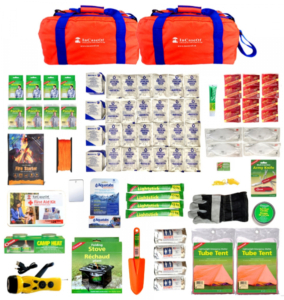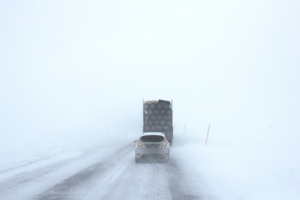Winter Preparedness: Cold Weather & Storms in Canada
As winter approaches, Canadians must brace for the challenges of harsh winters, or even winter storms. From blizzards to extreme cold, being prepared for cold weather emergencies is important. Let’s explore essential tips and examples to ensure your safety during frosty Canadian winters.
Let me preface this with the fact that I acknowledge that Canada is the 2nd largest (in land mass) country in the world. Which means, winter from Vancouver to Nunavut to New Brunswick differs immensely! Even from Northern BC, AB, SK to the southern parts of the provinces experience very different winters. Adapt your winter preparations accordingly.
Steps to Prepare for a Winter Emergency
1. Creating a Winter Emergency Kit:
Prepare a comprehensive winter emergency kit for your home and vehicle.
Home:
- Focus on food storage, water, first aid, a well stocked emergency kit, a shovel, ice melt, and your toboggan (for when the emergency is over of course). Check out this article for a very detailed list for an emergency home kit (or 72 hour kit).
Vehicle:
- Blankets or Sleeping Bags
- Flashlight and Batteries
- Shovel
- Ice Scraper and Snow Brush
- Sand or Kitty Litter – for traction
- Jumper Cables
- Basic Tool Kit: Items like a multi-tool, screwdriver, and wrenches.
- First Aid Kit

- Battery-Powered or Hand-Crank Radio
- Reflective Warning Triangles or Road Flares
- Tow Rope or Chain
- Extra Winter Clothing: Include hats, gloves, and extra layers.
- Non-Perishable Snacks: High-energy snacks like energy bars or nuts.
- Water Bottles: Be mindful of freezing temperatures
- Portable Phone Charger
- Spare Tire and Tools: Ensure your spare tire is in good condition at the beginning of each winter season, and that you have the necessary tools to change a tire.
- Car Escape Tool
2. Home Winterization:
Here are ideas how to winterize your home:
- Insulate Windows and Doors: Apply draft stoppers or weather stripping to windows and doors to prevent drafts. Install storm windows or use window insulation film to add an extra layer of protection.
- Seal Leaks and Gaps: Check for gaps and leaks in walls, ceilings, pipes, vents and floors. Use caulking or weather-resistant sealant to seal openings.
- Insulate Attic and Walls: Ensure proper insulation in your attic and walls. Adequate insulation helps retain heat and reduces energy costs.
- Service Your Heating System: Schedule regular inspection and maintenance for your heating system. Replace filters and ensure that vents and radiators are unblocked for efficient heat distribution.
- Check and Clean Chimneys: Have the chimney inspected and cleaned by a professional. Ensure the damper is working correctly to prevent drafts when the fireplace is not in use.
- Protect Pipes: Insulate exposed pipes to prevent freezing. Use pipe insulation or heat tape, especially in unheated areas like basements and attics. Disconnect garden hoses and turn off outdoor water faucets.
- Programmable Thermostat: Install a programmable thermostat to regulate temperatures efficiently. Lower the temperature when away and at night.
- Reverse Ceiling Fans: Change the direction of ceiling fans to clockwise. This helps circulate warm air trapped near the ceiling, keeping rooms warmer.
- Winterize Air Conditioning Units: If you have central air conditioning, cover the outside unit or remove window units.
- Stock Up on Winter Supplies: Ensure you have an adequate supply of winter essentials, including salt or ice melt for sidewalks, and a snow shovel.
3. Safe Winter Driving:

Here are a few safe winter driving tips:
- Prepare Your Vehicle: Ensure your vehicle is winter-ready by checking the battery, tires, brakes, and fluid levels. Have all-season or winter tires for better traction on snow and ice.
- Check Weather and Road Conditions: Stay informed about current weather and road conditions before you travel.
- Keep a Safe Distance: Increase your following distance in winter weather. Slippery roads take longer to stop on snow or ice-covered surfaces.
- Slow Down: Reduce your speed in adverse weather conditions. Driving at a slower pace allows you more time to react to unexpected situations.
- Avoid Cruise Control: In winter conditions, refrain from using cruise control. You want to maintain full control of your vehicle at all times.
- Clear All Snow and Ice: Before driving, clear all snow and ice from your vehicle, including windows, and hood. This improves visibility and prevents snow from blowing onto your windshield while driving.
- Use Headlights: Keep your lights on, even during daylight hours. Check taillights are functioning.
- Brake with Caution: Brake gently to avoid skidding. If your vehicle has anti-lock brakes (ABS), apply firm and continuous pressure. If you don’t have ABS, use a pumping motion to prevent skidding.
- Watch for Black Ice: Bridges, overpasses, and shaded areas are common locations for black ice.
4. Some Other Tips for Winter Conditions:

- Be Cautious Near Frozen Bodies of Water: Avoid walking or driving on frozen lakes, ponds, or rivers unless you are certain the ice is thick enough. Thin ice can be deceptive and pose a serious safety risk.
- Know the Signs of Hypothermia and Frostbite: Learn the symptoms of hypothermia (excessive shivering, confusion, slurred speech) and frostbite (numbness, tingling, or pain in extremities). Seek medical attention if you suspect either condition.
- Watch for Ice: Be cautious of icy surfaces, especially on sidewalks, driveways, and parking lots. Walk slowly, use handrails if available, and wear footwear with good traction.
- Stay Hydrated: Cold weather can be deceptively dehydrating. Drink plenty of water, and avoid excessive consumption of caffeine or alcohol, as they can contribute to dehydration.
- Dress Appropriately: Wear layered, insulated clothing, including a waterproof outer layer. Ensure you have a hat, gloves, and waterproof boots to stay warm and dry.
Conclusion:
By implementing the safety rules and winterization measures discussed, we fortify ourselves against the challenges that colder months bring. Whether it’s securing our homes, winterizing our vehicles, or adopting safe practices in various situations, each proactive step contributes to a defense against winter’s unpredictable conditions. As we navigate through winter’s frosty landscapes, let us prioritize safety and support one another. Stay warm, stay safe, and embrace the season with confidence.



